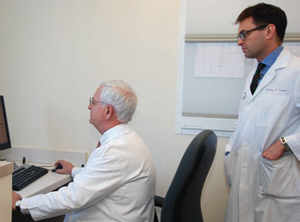From Prostate Cancer Research

At the annual meeting of the American Urological Association, Dr. Catalona* presents a prostate cancer update for the year that summarizes significant findings from studies published in peer-reviewed medical journals.
QUEST is adapting some information from his 2012 presentation to let readers know about current findings from recent prostate cancer research related to diagnosis and treatment.
The Facts 2012
Prostate cancer accounts for 29% of all male cancer, the most common malignancy in men, and 9% of male cancer deaths, second only to lung cancer.
241,740 new cases of prostate cancer were diagnosed in 2012.
There will be an estimated 28,170 prostate cancer deaths in 2012 vs. 33,720 for 2011.
If 1990 age-adjusted prostate cancer death rate was applied to 2007, there should have been 59,000 deaths. Instead, there were less than half as many.
The age-adjusted mortality rate for prostate cancer has strikingly decreased by 44% in the PSA era.
(Cancer Facts 2012 – www.cancer.org)
Smoking, PC Survival, and Recurrence
Smoking at time of biopsy is associated with an increased prostate cancer death rate.
The prostate cancer specific death rate was 59% higher for smokers.
Smokers had increased death rates, PSA recurrence, total death rates and cardiovascular death rates.
Quitting smoking 10 years previously was equivalent to not having smoked for these statistics.
Kenfield S et al. JAMA 2011;305:2548-55
SELECT Trial (Selenium & Vitamin E)
Selenium did not reduce prostate cancer risk and Vitamin E was associated with increased risk.
Klein et al. JAMA 2011; 306: 1549
Vitamin-E, Soy and Selenium in Men with HG-PIN
Neither selenium, vitamin E nor soy have benefit in preventing men progressing from HG-PIN to prostate cancer.
HG-PIN (High-grade prostatic intraepithelial neoplasia) is a pathology finding that would come after a needle biopsy or a post prostatectomy biopsy. It is not normal prostate tissue but it is not cancerous either. Some pathologists believe PIN to be a pre-cancerous condition.
Still, without a seemingly helpful effect, numerous over the counter supplements are sold and men continue to buy them.

Fleshner N et al.J Clin Oncol. 2011;29:2386-90
BPH and Prostate Cancer
Surprisingly, BPH (benign prostatic hyperplasia or enlarged prostate) and prostate cancer are strongly related.
In a Danish study assessing the relationship of BPH and prostate cancer, men were followed up to 27 years.
The findings showed clinical BPH was associated with a 2-3 times risk of prostate cancer and a 2-8 times increased risk of prostate cancer death compared to those diagnosed without BPH.
Orsted DD et al. Eur Urol 2011;60:691-8
Dutasteride and Prostate Cancer Risk
Not only are dutasteride (Avodart, Jalyn) and finasteride (Proscar) not indicated for prostate cancer prevention, the drugs now carry a warning about possible risk of high-grade cancer.
These drugs, called 5ARIs (5-alphareductase inhibitors), lead to fewer biopsies, but not less cancer.
Walsh PC. J Urol 2011;186:530.
Prostate Cancer Biopsy and Dutasteride
Dutasteride slows down a rising PSA and therefore is a concern in assessing PSA results in men taking this drug (Avodart or Jalyn).
Any rising PSA for a patient using dutasteride should be an indication for prostate biopsies.
Eur Urol. 2011;59:183-90.; Walsh PC, J Urol 106
Baseline PSA is important
A baseline PSA in a man’s 40’s is recommended because baseline PSA levels in the 40’s predict prostate cancer risk and aggressiveness.
The median PSA levels are 0.4-0.7 ng/mL in the 40’s and 0.7-1.0 ng/mL in the 50’s.
Loeb et al. Eur Urol 2012; 61: 1-7
New Prostate Cancer Gene Mutation: HOXB13
A new HOXB13 gene mutation (on chromosome 17) was discovered by sequencing familial prostate cancer cases.
The gene was present in all 18 prostate cancer cases from 4 families in which the HOXB13 mutation was found.
It appears that the rare HOXB13 mutation is associated with a 20 times increased risk for familial prostate cancer.
As personalized gene testing becomes more accessible and affordable, these types of findings are going to become increasingly useful and important.
Ewing et al. NEJM 2012; 366: 141-9
Newer MRI Technology
Improvements in MRI technology may finally justify its more frequent use in detecting and staging prostate cancer.
Previously, poor sensitivity limited the use of MRI as a screening tool.
With diffusion-weighted imaging and dynamic contrast enhancement as well as better MRI coils and stronger MRI magnets, the resolution can be much better and the results are more useful clinically in identifying small areas of unsuspected prostate cancer.
Wu J et al. J Urol 2011;186:1756-7
PSA Velocity Risk Count
(see article in Summer/Fall 2012 QUEST www.drcatalona.com)
PSA velocity risk count, that is the number of times the PSA increases by 0.4 ng/mL per year, improves the specificity of screening for life-threatening prostate cancer.
Loeb et al. BJUI 2012; 109: 508

Delay of Surgery
1,111 men in this study had low risk prostate cancer.
Comparing those who waited more than six months for their operation to those who hadn’t, the results were dramatic.
A Gleason score of 7 or more was found in 47% of patients who had delayed surgery versus 27% in those who had not.
Delayed patients also had a greater risk of recurrence, 50% vs. 12%.
Patients need to be counseled about delaying surgery. These findings may also have validity for patients on active surveillance or watchful waiting.
O’Brien et al.J Urol 185:2143-7,2011
Gleason Upgrade After Radical Prostatectomy and Subsequent Tumor Recurrence
Patients whose biopsy Gleason Score was raised after the post-surgical biopsy had a higher rate of recurrence than those whose score did not. In this study of 1629 men, 28.6% had an upgrade in their final Gleason score.
Corcoran, NM, et al. BJUI, 2011;108:e202-10
Risk For Prostate Cancer-Specific Mortality After Radical Prostatectomy
The risk for prostate cancer-specific mortality shows a constant increase for at least 15 years; therefore, patients need to be followed long-term.
And studies that do not yet have 15 years of follow-up are not sufficiently mature to yield reliable results.
Shikanov S et al. J Urol 187:124-8, 2012
RT/ADT vs. ADT For Locally Advanced Disease
This study showed that radiation therapy with hormonal therapy (androgen deprivation therapy) improves the overall survival of men with locally advanced prostate cancer with few harmful side effects.
Warde et al. Lancet 378:2104, 2011/Liauw
ADT For Intermediate Risk Cancer Treated With RT
Six months of hormonal therapy along with radiation therapy, rather than 3 months of hormonal therapy, improves the survival rate for prostate cancer with those having a Gleason score 7. This applies only to men who are receiving radiotherapy.
D’Amico et al. JCO 29:4682 2011/Liauw
* This year Dr. Catalona was supported in his presentation by the following participants: Robert B Nadler, MD., Northwestern University, Chicago, IL; Douglas M Dahl, MD Harvard University, Massachusetts General Hospital, Boston, MA; Stanley L Liauw, MD University of Chicago, Chicago, IL; Stacy Loeb, MD, New York University, New York, NY
High-grade prostatic intraepithelial neoplasia











